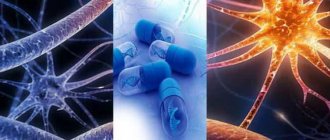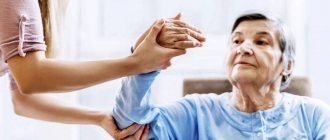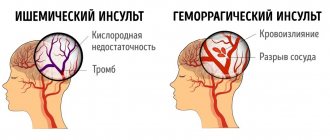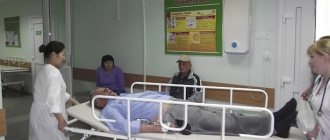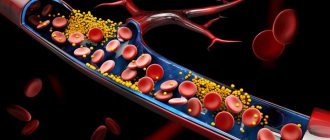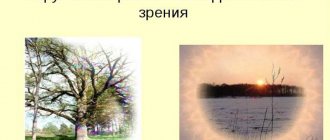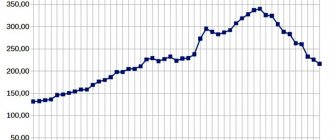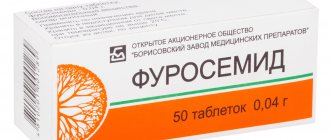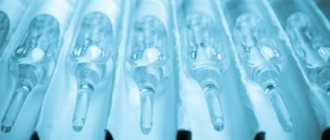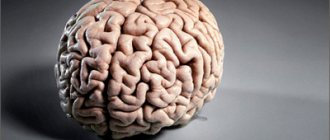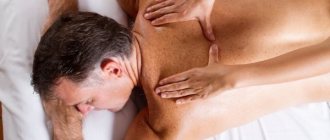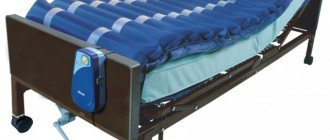Massage after a stroke is the most important part of the rehabilitation process. Its implementation on a regular basis is so important that people caring for the patient are advised to acquire the necessary skills and knowledge and carry it out at home.
It complements the medications, exercises and general measures necessary to recover from a shock.
Beneficial properties of massage
When performing massage actions, a mechanical effect occurs on the tissues of the body. Its benefits have long been known and studied, which leads to its active use in rehabilitation after stroke of any type and location.
Various techniques used in massaging movements are aimed at achieving several goals:
- Improve the functioning of all organs. These are muscle tissue, bone apparatus, digestive, cardiovascular and urinary systems.
- Prevent the occurrence of stagnation. This is especially important when movement is limited.
- Remove toxins. Accelerating blood flow to organs simultaneously promotes the removal of metabolic products that have a destructive effect on cells. Blood also washes away the remains of dead cells, preventing them from poisoning the body.
- Stabilize the flow of lymph and blood. Body fluids move faster through the body.
- Improve cellular metabolism. Stimulation of blood flow normalizes the supply of oxygen and nutrients to all body tissues.
- Provide skin nutrition to immobilized patients. This helps prevent bedsores.
- Relieve muscle spasms. The relaxing effect leads to the relief of pain syndromes.
- Restore normal functioning of the limbs. Improved blood circulation, absence of spasms, and the constant load that massage brings, restores the functions of legs and arms affected by a stroke.
- Help the joints work freely. Exercises give them flexibility and mobility.
For reference. In addition to the direct physical impact, massaging actions have a powerful psychological effect on a person. It has been proven that the emotional background and psychological mood are the factors that determine the healing process.
The procedure, performed in a cozy environment with soft hands, calms, restores a positive attitude, and helps eliminate signs of depression. Improving your mood, in turn, allows you to believe in yourself and achieve recovery.
Unique healing properties, however, become such only if performed correctly.
Indications for use
Therapeutic massage after a stroke is indicated for paralysis of the face, torso, and limbs. It is prescribed for motor dysfunctions and decreased sensitivity.
Important. When bedsores appear, massage actions help to activate metabolism in the affected area and prevent the process of tissue death.
Stroking the face with Actovegin injections into the nerve fiber helps restore the impaired innervation of the peripheral nerves involved in facial movements.
Contraindications
Attention. It is well known that massage is useful for stroke, but there are conditions in which it is prohibited.
With an aortic aneurysm, mechanical impact provokes its rupture, bleeding and death.
Exercise with high or unstable blood pressure creates a risk of stroke recurrence.
If the patient is in a serious condition without consciousness, it is impossible to monitor the effectiveness of the procedure.
If the left part of the temporal gyrus is damaged for currently unknown reasons, the likelihood of expansion of the lesion and recurrent stroke .
It is also prohibited to apply mechanical force at high temperatures, exacerbation of diabetes mellitus, acute infection, respiratory problems, or skin inflammation.
Contraindications to any exercise are vein thrombosis, thrombophlebitis, and the risk of rupture of an atherosclerotic plaque.
Before starting a course, you should always consult a doctor to see if a patient can have a massage if they have a stroke. Perhaps he will point out other contraindications.
Peculiarities
Stroke claims thousands of lives every year. This is a diverse pathology that affects the entire human body. This is the main reason why any influence on muscles and tissues in this disease must be used carefully.
It is difficult for a non-specialist to foresee the specifics of mechanical effects on organs. Before the first session, you need to carefully read the basic rules for performing massage after a stroke and find out how to do it correctly.
Who conducts
The subtleties of rehabilitation massage after a stroke are familiar only to a person who has studied it and completed practice. The best way for a loved one to become familiar with the procedure is to complete special courses. Another option is to watch how a specialist conducts it and learn the basic techniques.
For reference. Periodically you need to consult a massage therapist or rehabilitation therapist. This way it will be possible to make a correction or change tactics.
When to start
Massage after a stroke is needed primarily to stabilize the patient’s well-being. During this time, the body gets used to the pathology, blood pressure, breathing, and heartbeat will be restored, and brain swelling will be eliminated.
Massage for
ischemic stroke begins three days after the onset of new symptoms. It is performed carefully, taking into account that this type of disease is extremely dangerous.
General rules
The first procedures are always performed by specialists, since this period is the most critical. Massage procedures can be performed at home when the patient's condition has stabilized. In order not to harm the patient with your manipulations, before the debut session you need to undergo training from a professional massage therapist. Before starting practice you must:
- know about all contraindications in general and working on individual areas for a particular patient in particular;
- know which muscles of the patient require stretching, relaxation, and which stimulation;
- master four basic techniques (stroking, rubbing, kneading, vibration), and also learn to control the intensity of their implementation;
- master the skills of proper positioning of paralyzed limbs;
- have a treatment plan agreed upon with the attending physician.
General recommendations
While the impact victim is in the hospital, the issues of care and recovery seem clear and understandable. But when he returns home, the adaptation process turns out to be extremely difficult.
Massage after a stroke at home is performed taking into account several recommendations:
- You need to create a calm environment. This will make him feel safe and relaxed.
- The most comfortable time for procedures is before lunch. At first, classes should take no more than five minutes. Gradually their duration increases to forty minutes or even an hour.
- In the first stages, the effect is weak, light, this is the only way to protect the patient from an increase in blood pressure. If the patient has predominantly weakness of the limbs, but simple skills and walking are intact, the session begins with a full study of muscle tissue. All movements are made smoothly and accurately.
- The dependence of effort on the level of hypertonicity is highlighted. The higher the tone, the softer it is recommended to apply the effect.
- The work begins on the healthy side. This way the body can adapt to the procedure.
- Before starting, the patient’s skin is washed, dried, and a massage cream is applied to it.
- If the patient is prone to convulsions, taking antispasmodics or paraffin baths is indicated before the session.
- The direction of movement corresponds to the flow of lymph.
- Working on those parts of the body where many receptors are located can give a severe reaction and cause spasms. These areas include the Achilles tendon, the front of the thigh, wrist, forearm, and inner shoulder.
Important. During all massage sessions, the condition of the victim is carefully monitored. If his skin turns pale, his breathing becomes shallow, his pulse quickens, he needs to reduce the intensity or stop the procedure altogether.
It is imperative to keep a diary of blood pressure, heart rate and complaints. Data is recorded in the morning, lunchtime and evening.
Therapeutic exercises
Simultaneously with massage sessions, restorative passive gymnastics are performed. To do this, raise and bend the lower and upper limbs (without causing pain or tension). To restore mobility to the facial muscles, do the following exercises:
- they place a palm on their forehead and ask them to raise their eyebrows;
- alternately close and squint your eyes;
- puff out and retract the cheeks;
- open and close the mouth wide;
- smile widely;
- move the jaw to the right and left.
When performing exercises, you can help the patient with your hands.
The recovery period after a stroke requires not only drug therapy, but also regular massage treatments. The course, intensity and duration of sessions are selected individually in each case. Massaging always begins on the healthy side and gradually moves to the affected areas. During the massage, the patient can lie on both the healthy and the paralyzed side. After the session, the patient is given time to rest, covered with a warm blanket.
Hand massage
Before starting a hand massage after a stroke, the pectoralis major muscle is worked out. After an attack she is always tense.
They start working with the shoulder muscles, then work with the triceps. Move on to the biceps, forearm. Complete the procedure on the hands.
From the inside of the shoulder, the impact should be very soft. This is the place where large vessels pass. When working the forearm, the main emphasis is on the outer surface, and light manipulations are performed on the inner surface. This part of the arm is usually prone to spasms.
Foot massage
For reference. In order to optimally work out the muscle tissue of the lower extremities, the patient lies on his back. It is more convenient and effective to work with the back of the thigh in a position lying on your side or stomach.
Begin leg massage after a stroke from the level of the knee, moving to the groin. Rubbing and gentle stroking are used.
The lower leg is massaged from the foot up to the knee. All movements are made with the full palm, as well as with the fingers. You need to be extremely careful with muscle tissue - with intense pressure there is a high probability of spasms.
When massaging the foot, hold the heel with one palm, and with the other make the necessary rubbing, stroking movements.
How often to conduct sessions
The best option is to conduct massage sessions little by little and daily. As practice shows, in this case, the restoration of motor activity occurs faster. This schedule is the most optimal. If it is impossible to do a massage every day (for example, at home after discharge), you should do it as often as possible, at least every other day. How quickly and completely the patient recovers depends on how the treatment is carried out.
Most often, sessions are held every day or every other day. From 5 minutes at the first session, the duration gradually increases to 20 minutes. The number of sessions, as a rule, ranges from 12 to 20 procedures, but may be different, selected individually, depending on the condition.
A more precise number of sessions, as well as their duration, can only be determined by the attending doctor. The massage therapist is obliged to closely monitor the patient’s condition during the procedure, and at the slightest sign of deterioration, stop the session.
Face massage
The benefit of the effect on the facial muscles is determined by the doctor. It is aimed at restoring facial expressions and speech. They begin classes no earlier than fourteen days after the stroke. They are carried out only on the injured side.
Bilateral massage is performed after rehabilitation of lost functions.
At the beginning of the session, vibrating movements are used over the entire area of the head, concentrating on the back of the head. After repeating several times, touch the bottom of the forehead with an open palm and sharply move it upward. Return to the head. Knead, rub it easily, softly, without tension.
Next they turn to the forehead again. First, press the muscle with your palm in the area of the eyebrows, then move upward. Repeat the same movement with the pads of two fingers.
For reference. Place the edge of the palm on the middle part of the forehead and move it towards the temples. Take a small ball, apply it to the eyebrows and roll it to the place where the hair grows, then down. The affected side of the forehead is tapped with your fingers.
They begin to work with the skin around the mouth. Using a ball, smooth around the lips. Knead and smooth with fingers.
Proceed to massaging the cheeks. They are performed with light tapping and stroking.
Duration of sessions and courses
Sessions can begin only when the patient’s general condition is normalized. Depending on the form of the stroke, this period is:
- Two to three days – for ischemic stroke
- From 5 to 7 days - for hemorrhagic form.
The above terms are conditional, and the entire course can be prescribed only after consultation with a rehabilitation doctor.
2-3 days after the attack, only light massaging and turning to one side are allowed. Only after 7 days a massage session is allowed. However, its duration should not exceed 5 minutes.
If the first session was successful and the patient’s condition does not worsen, then the duration of the session should be gradually increased. Massage is recommended to be carried out every day 2-3 times a day , and the course should be 20-30 procedures, taking into account the individual characteristics of the patient.
After a full course, the patient is given a break for a period of 3 weeks to a month.
One side massage
Attention. If one side is paralyzed, at first any action is performed only by a massage therapist.
In case of a stroke on the right side, the massage is performed by first warming up the affected parts with a heating pad.
Move from the neck towards the ear and chin. Work the arm from the hand up towards the shoulder. Next they work on the ribs, from them to the armpit, reaching the hips. Descend to the shin, continue from the knees to the pelvis. They go down and massage the leg from the foot to the knee. Finally, the foot is affected.
Massage for a stroke on the left side is also done.
Rules and goals of massage after a stroke
Muscles after a stroke have varying degrees of tension. Some of them are completely relaxed and in a normal functional state, the other part is toned and hypertonic. It is impossible not to pay attention to this, since massage procedures are aimed at relaxation and activation of metabolic processes in them.
If a stroke occurs on the left side, special attention is paid to the affected right side and vice versa. The duration of the first massage sessions is no more than 5 minutes, gradually increasing to 10 minutes and then up to half an hour.
In case of a stroke on the right side, massage actions begin with the healthy half of the body, that is, with the left. The affected half of the body must first be warmed, especially the limbs. You can use a heating pad or a plastic bottle with warm water, or a warm blanket. The temperature should be comfortable; overheating should not be allowed. Massage is done using stroking, rubbing movements, without the use of force.
Limb massage can begin 3-4 days after the attack. Performing time is 1-2 minutes for each limb, gradually the duration of the procedure is increased to 7-10 minutes.
When massaging the right and left arms, massage techniques are performed in the direction from the shoulders to the hands. The hand is moved to the side as much as possible and fixed in the correct position: all joints are straightened, the palm looks up, the fingers are straightened and spread apart. A bolster, rolled up towel or pillow can be used for fixation. The impact should not be pressing and especially painful, rather soft, with little force and without deep kneading, but quite intense. Relax the muscles by rubbing, light kneading and stroking.
Massage your arms, moving from top to bottom, from shoulder to hand
The massage is based on the principles of differentiation: those muscles that are tense should be affected by soft and light rubbing and stroking movements with low intensity, and muscles that are relaxed and atrophic should be massaged with greater speed and pressure.
The massage therapist's hand movements should be soft and smooth; intensive rubbing or kneading with great force is not recommended.
When massaging the leg, the correct direction of movement is from the hip to the foot. To work the flexor and extensor muscles, the limb is bent, giving it a physiological position. You can use a roller or pillow for this.
At the initial stage, the impact is superficial; if the patient has no complaints and feels well, deeper kneading movements can be used. Do not lift your hands during the massage, making vibrating movements and longitudinal kneading.
In case of paralysis, it is recommended to start any massages with a healthy part of the body, and warm the affected part with a heating pad. The technique of influencing the muscles varies depending on the tone they are in (relaxed or tense).
A stroke also causes paralysis of the facial muscles on one side, which leads to facial distortion. Facial massage helps restore the movement of facial muscles and normal facial expression.
There are a large number of text guides and tips on how to do massage yourself after a stroke, however, to better master the massage technique, it would be more effective to familiarize yourself with a video of massage after a stroke, which shows the correct execution of movements used by qualified massage therapists; it is even better to consult with a licensed specialist or undergo training with him.
Using electric massagers
Electric massagers are used for self-massage. They have vibration and infrared heating functions. What makes its use inconvenient is that it does not allow you to control the depth and accuracy of the impact, unlike a manual one.
For reference. If painful sensations appear in the muscles, the session is stopped or the intensity of vibration is reduced.
Restorative massage after a stroke is performed by specialists, as well as loved ones who take care of the patient. The impact on the patient’s body returns impaired motor activity and sensitivity. Proper massage improves blood circulation, metabolism, and mood.
The benefits of massage treatments
The main goal of massage is to restore the patient's ability to move. However, this is not all that can be achieved with its help:
- Massage for stroke improves the functioning of internal organs.
- Prevents the development of stagnant processes, such as pneumonia.
- Improves metabolism in the skin and prevents the formation of bedsores.
- Thanks to a restorative massage, pain is eliminated and muscle tone is reduced.
- The muscles become firm and elastic.
- By improving blood circulation, the functions of paralyzed limbs are restored.
- The movement of lymph through the vessels is normalized.
- Accumulated toxins are removed from the body.
- Swelling decreases.
- Joint mobility is restored.
Massage also has a good effect on the psycho-emotional state of the patient. It helps prevent depression and energizes you with positivity.
Indications and contraindications
Rehabilitation massage after a stroke is indicated in several cases:
- increased muscle tone;
- limbs move involuntarily;
- pathological tendon reflexes occur;
- mobility is partially or completely absent;
- stiffness and pain are felt when moving;
- there is a symptom of conjugal movements (syncinesia).
Despite the positive effects, sometimes the procedure is not recommended:
- at elevated body temperature;
- with a persistent increase in blood pressure;
- for headaches or heart pain;
- in case of disturbances in the functioning of the respiratory system.
